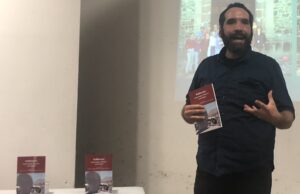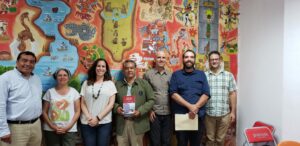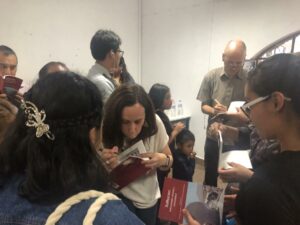Engaged Anthropology Grant: Christopher Morehart

Christopher Morehart received a Dissertation Fieldwork Grant in 2007 to aid research on “Agricultural Landscapes and Political Economy at Xaltocan, Mexico,” supervised by Dr. Elizabeth M. Brumfiel. In 2012 Dr. Morehart continued his research when he received a Post-Ph.D. Research Grant to aid research on “Environmental Interaction and Political Transformation in the Northern Basin of Mexico”. After receiving an Engaged Anthropology Grant in 2016 Morehart began working on a, “Collaborative Development of a Book on the Archaeology of Xaltocan, Mexico for Community Members”.
This report presents an overview of a Wenner-Gren engaged anthropology grant project. Funds from Wenner-Gren were used to finance the creation of a book on the archaeology of Xaltocan. Xaltocan is a contemporary town approximately 35 km north of present-day Mexico City with a history that has lasted well over 1000 years. It is also one of the most continuously studied archaeological sites in central Mexico. Archaeologists first visited the town very briefly in the 1950s and again in the early 1970s.
However, in the late 1980s, Elizabeth Brumfiel initiated a long-term archaeological project in Xaltocan, with the promise that she would always seek to engage actively with community members and address questions that they have about their own past. Several other archaeological projects have occurred in the town over the past 15-20 years, all directed by Brumfiel’s students or former students (many funded by Wenner-Gren). Members of the town have a strong interest in their past and in the work archaeologists have been doing. This relationship is a unique example of productive, engaged archaeology. Many archaeologists have created museum exhibits (some financed by Wenner-Gren) as well as public talks and other events.

Unidentified member of the community pictured holding book, Enrique Alegría Rodríguez (UT Austin), Chris Morehart (ASU), John Millhauser (North Carolina State U)
This project was planned to provide a more tangible and lasting contribution to the community. This book is based on the archaeological work of several researchers, from the United States and Mexico, as well as the experiences and leadership of local historians and organizers. This book is not an academic article or a technical report, both of which are supplied to community members and officials as part of ongoing projects. It is a book written specifically for the community of Xaltocan, written in an engaging, accessible and dynamic prose.
Plan of the book
Although I wrote the grant proposal, I worked closely with Enrique Rodríguez Alegría and Kristin De Lucia, two other archaeologists who have worked in Xaltocan. The book contains 13 substantive chapters, each written either by a researcher or group of researchers who has carried out an investigation in Xaltocan or by a local leader engaged in promoting cultural and historical affairs in the town. Each chapter is brief, 3-4 pages, and written in an accessible prose (in Spanish). At the end of the book, we have included a fairly comprehensive bibliography of publications on the history and archaeology of Xaltocan. Below is a list of the chapters:
Capítulo 1. La historia de la arqueología en Xaltocan, by Enrique Rodríguez-Alegría
Capítulo 2. El medio ambiente de la cuenca de México y del lago de Xaltocan, by John K. Millhauser
Capítulo 3. Antes de Xaltocan, by Christopher Morehart, Abigail Meza Peñaloza, and Destiny Crider
Capítulo 4. La formación de un reino, by Kirby Farah
Capítulo 5. Los grupos domésticos y la comunidad, by Kristin De Lucia
Capítulo 6. Las chinampas de Xaltocan, by Christopher Morehart
Capítulo 7. Impuestos, tributos y mercados, by John K. Millhauser
Capítulo 8. La religión y los ritos de los grupos Domésticos, by Kristin De Lucia
Capítulo 9. Xaltocan y el imperio azteca, by Lisa Overholtzer
Capítulo10. Xaltocan en el periodo colonial, by Enrique Rodríguez-Alegría
Capítulo 11. La historia genética de Xaltocan, by Deborah A. Bolnick, Jaime Mata-Míguez and Austin W. Reynolds
Capítulo 12. La casa de cultura de Nextlalpan “Cualcalli”, by Filemón Hernández Zambrano
Capítulo 13. El museo arqueológico de Nextlalpan en Xaltocan, by Sergio Maya Rodríguez Una bibliografía de la investigación arqueológica en Xaltocan
Distribution of the book

Distributing the book to the community of Xaltocan was an important goal of the project. We produced 315 printed copies and donated them to the town’s cultural center and museum. We worked with local organizers in order to plan an event to present and distribute the book. This occurred in July 2019 at the Casa de la Cultura (cultural center) in the center of Xaltocan. I gave a brief presentation of the book to approximately 60 to 70 attendees. The director of the cultural center (also one of the book contributors) decided to give a copy of the book for free to all in attendance, with the option of a small contribution (virtually everyone contributed something), after which the book would be sold at a price determined by the cultural center.
The presentation of the book was a great success, and attendees were very enthusiastic about the book.